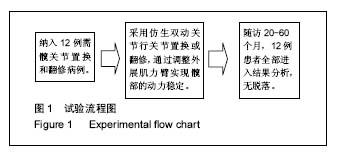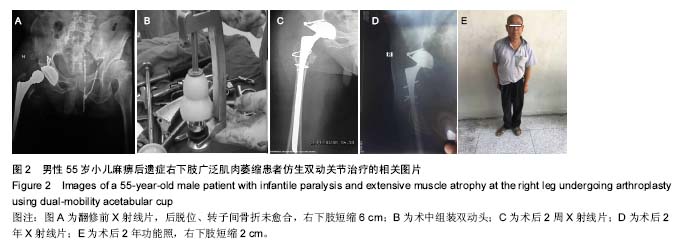| [1] 周勇刚,张强,陈继营,等.大直径股骨头假体在人工髋关节翻修术中的应用[J].中华外科杂志,2012,50(5):389-392.[2] Mohammed R, Hayward K, Mulay S, et al. Outcomes of dual-mobility acetabular cup for instability in primary and revision total hip arthroplasty. J Orthop Traumatol. 2015;16(1): 9-13.[3] Lutonský M, Valis M, Srot J.Total hip arthroplasty after femoral neck fracture in patients with acquired neurological deficit.Acta Chir Orthop Traumatol Cech. 2009;76(3):239-242.[4] Sonohata M, Kitajima M, Kawano S, et al.Total Hip Arthroplasty for the Paralytic and Non-paralytic Side in Patient with Residual Poliomyelitis.Open Orthop J. 2016;10:105–110.[5] Yoon BH, Lee YK, Yoo JJ, et al.Total hip arthroplasty performed in patients with residual poliomyelitis: does it work? Clin Orthop Relat Res. 2014;472(3):933-940. [6] Bradley S. Raphael, Joshua S. Dines, Meredith Akerman, et al. Long-term Followup of Total Hip Arthroplasty in Patients with Cerebral Palsy.Clin Orthop Relat Res. 2010; 468(7): 1845-1854.[7] Renner L,Drwal V,Boettner F. Hip replacement in patients with neuromuscular disorders.Orthopade. 2015;44(7): 546-554. [8] D'Apuzzo MR, Nevelos J, Yeager A,et al. Relative head size increase using an anatomic dual mobility hip prosthesis compared to traditional hip arthroplasty: impact on hip stability.J Arthroplasty.2014;29(9):1854-1856. [9] Howie DW, Holubowycz OT, Middleton R. Large femoral heads decrease the incidence of dislocation after total hip arthroplasty: a randomized controlled trial.J Bone Joint Surg Am. 2012;94(12):1095-1102. [10] Park KS, Seon JK, Lee KB, et al.Total hip arthroplasty using large-diameter metal-on-metal articulation in patients with neuromuscular weakness.J Arthroplasty. 2014;29(4):797-801.[11] 卢世璧,王继芳,王岩,等.坎贝尔骨科手术学[M].10版.济南:山东科学技术出版社,2005:377-382.[12] Mohammed R, Hayward K, Mulay S,et al.Outcomes of dual-mobility acetabular cup for instability in primary and revision total hip arthroplasty.J Orthop Traumatol.2015; 16(1):9-13.[13] Philippot R, Meucci JF, Boyer B, et al.Modern dual-mobility cup implanted with an uncemented stem: about 100 cases with 12-year follow-up.Surg Technol Int. 2013;23:208-212.[14] Boyer B, Philippot R, Geringer J, et al.Primary total hip arthroplasty with dual mobility socket to prevent dislocation: a 22-year follow-up of 240 hips. Int Orthop. 2012;36(3):511-518.[15] Ko LM, Hozack WJ.The dual mobility cup: what problems does it solve?Bone Joint J. 2016;98-B(1 Suppl A):60-63.[16] Combes A, Migaud H, Girard J, et al. Fessy MH.Low rate of dislocation of dual-mobility cups in primary total hip arthroplasty.Clin Orthop Relat Res. 2013;471(12):3891-3900. [17] Fabry C, Langlois J, Hamadouche M, et al. Intra-prosthetic dislocation of dual-mobility cups after total hip arthroplasty: potential causes from a clinical and biomechanical perspective. Int Orthop. 2016;40(5):901-906. [18] 宋伟毅,刘忠堂,王兵,等.髋关节置换治疗老年偏瘫侧股骨颈骨折[J].中国矫形外科杂志,2012,20(10):942-943.[19] Ng DZ, Lee KB.Unipolar versus Bipolar Hemiarthroplasty for Displaced Femoral Neck Fractures in the Elderly: Is There a Difference? Ann Acad Med Singapore. 2015;44(6):197-201.[20] Nich C, Vandenbussche E, Augereau B, et al. Do Dual-Mobility Cups Reduce the Risk of Dislocation in Total Hip Arthroplasty for Fractured Neck of Femur in Patients Aged Older Than 75 Years? J Arthroplasty. 2016;31(6):1256-1260. [21] Bensen AS1, Jakobsen T, Krarup N. Dual mobility cup reduces dislocation and re-operation when used to treat displaced femoral neck fractures.Int Orthop. 2014;38(6): 1241-1245. [22] Carulli C, Macera A, Matassi F, et al .The use of a dual mobility cup in the management of recurrent dislocations of hip hemiarthroplasty.J Orthop Traumatol. 2016;17(2): 131-136.[23] Murena L, Fattori R, Scamacca V, et al. Treatment of intracapsular fractures of the proximal femur with bipolar hemiarthroplasty in patients under the age of 70: clinical and radiographic results at mean 20 years follow-up.Acta Biomed. 2016;87 Suppl 1:53-59.[24] Fichman SG, Mäkinen TJ, Vincent A, et al. Complications following conversion of a hip hemiarthroplasty to a total hiparthroplasty..Int Orthop. 2015;39(12):2335-2339.[25] Morsi E, Habib ME, Elseedy A, et al. Revision of failed hip hemiarthroplasty. Classification, management, and follow-up. J Orthop. 2016;13(2):63-68. [26] Laguna R, Barrientos J.Total hip arthroplasty in paralytic dislocation from poliomyelitis. Orthopedics. 2008;31(2):179.[27] Suh KT, Kim DW, Lee HS, et al. Is the Dislocation Rate Higher after Bipolar Hemiarthroplasty in Patients with Neuromuscular Diseases?Clin Orthop Relat Res. 2012; 470(4): 1158-1164.[28] Kim Y, Kim JK, Joo IH, et al. Risk Factors Associated with Dislocation after Bipolar Hemiarthroplasty in Elderly Patients with Femoral Neck Fracture. Hip Pelvis. 2016; 28(2): 104-111.[29] Werner BC, Brown TE.Instability after total hip arthroplasty. World J Orthop. 2012; 3(8): 122-130.[30] Rao BM, Kamal TT, Vafaye J, et al.Surgical repair of hip abductors. A new technique using Graft Jacket allograft acellular human dermal matrix.Int Orthop. 2012;36(10): 2049-2053. [31] Whiteside LA.Surgical technique: Gluteus maximus and tensor fascia lata transfer for primary deficiency of the abductors of the hip.Clin Orthop Relat Res. 2014;472(2): 645-653.[32] Kohl S, Evangelopoulos DS, Siebenrock KA, et al. Hip abductor defect repair by means of a vastus lateralis muscle shift.J Arthroplasty. 2012;27(4):625-629.[33] Laguna R, Barrientos J.Total hip arthroplasty in paralytic dislocation from poliomyelitis.Orthopedics. 2008;31(2):179.[34] Plummer DR, Haughom BD, Della Valle CJ.Dual mobility in total hip arthroplasty.Orthop Clin North Am. 2014;45(1):1-8. |
.jpg) 文题释义:
文题释义:

.jpg)
.jpg) 文题释义:
文题释义: